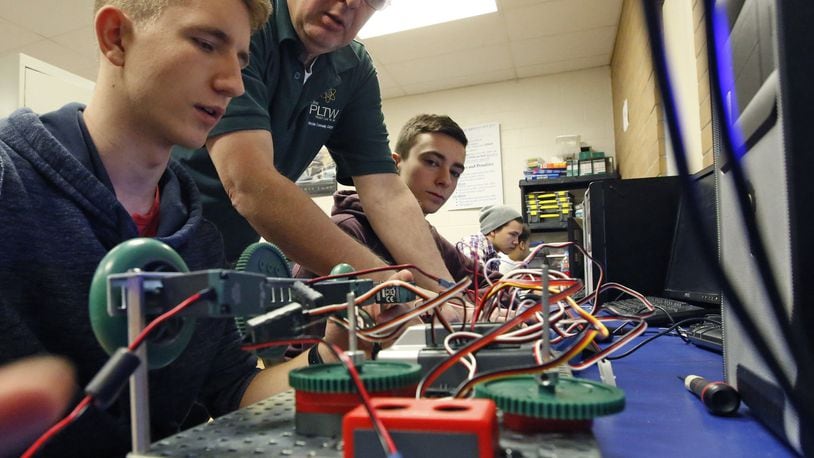About 44 percent of Ohio school districts did not rate any teachers as “developing” either, meaning they placed every single teacher in the top half of the rating system, calling them “accomplished” or “skilled.”
RELATED: Educators urge broader look at school quality
RELATED: Changes coming for teacher evaluation system?
That includes Greenon and Edgewood, who got D’s in achievement on the recent state report card, Xenia and Carlisle, who got F’s in student growth, and Jefferson Twp., which had the worst four-year graduation rate in the state.
“In the Ohio Teacher Evaluation System rubric, I almost think it would take an effort to be rated ineffective,” said Fairborn Curriculum Director Sue Brackenhoff, who was a school principal for 20 years. “It would have to be that you’re not trying. And I rarely see that type of teacher.”
Report card link?
Teacher evaluations are completed primarily by school principals, with 50 percent of the grade based on observation of teacher planning, instruction and professionalism. The other 50 percent is based on student growth, which can be measured in multiple ways, including “value added” data from state tests. An alternate method allows for only 35 percent focus on student growth.
Educators on both the teacher side and the school administrator side argued that there’s a disconnect between school report card grades and teacher evaluation ratings.
“They’re measuring two different things,” said Melissa Cropper, president of the Ohio Federation of Teachers. “I think the testing piece is more of a false indication of what is happening than (classroom observation).”
Tom Ash, director of governmental relations for the Buckeye Association of School Administrators, said evaluations were primarily designed to improve teaching in the classroom, adding that many teachers don’t even teach subjects that have state exams.
RELATED: Schools focus on behavior to boost learning
RELATED: Local schools adjust on the fly to graduation changes
“I don’t think teacher evaluations should or can be aligned with the report card,” Ash said. “A principal will consider the teacher’s relationship with parents, and that’s not measured on the district’s report card. Collaborative skills and classroom management are not reflected on the report card either, but those are all part of a good solid evaluation.”
Brackenhoff said Fairborn’s data shows how different the report card is from the evaluations. Fairborn got an “F” in student progress this year after a “D” last year. But she said 72 percent of Fairborn teachers had the top evaluation rating on the student growth measure and less than 1 percent had the lowest rating.
“That’s a difficult situation for educators to try to explain to the public,” she said.
The Ohio Department of Education did not respond to a request for comment on the data.
Teacher rating data
No school district in Ohio rated more than 2.6 percent of its teachers as ineffective, and Northridge, Trotwood and Dayton were the only districts in the greater Miami Valley to grade any teachers as ineffective. Dayton teachers union President David Romick said it was staggering how few teachers were in that category.
The next higher rating is “developing” and only two dozen districts statewide (out of 608) rated as many as 10 percent of teachers in that category. Trotwood and Dayton called 14 percent of teachers developing, while Springfield rated 11 percent that way.
Springfield was one of three districts in Ohio that did not rate any teachers in the highest category of “accomplished.” Superintendent Bob Hill said that was because the district’s very low student growth scores were applied to all teachers in a technique called “shared attribution.” Hill called the ratings “flawed” and “somewhat meaningless.”
RELATED: Many students attend e-schools amid controversy
RELATED: Local schools post best, worst scores in Ohio
“The state evaluation system, specifically the student growth portion of it, fails to take into account student poverty, mobility, and many other factors that research shows contributes to student achievement and growth,” Hill said.
Hamilton Superintendent Tony Orr echoed Hill, questioning the underlying tests that are used to determine student growth measures for many teachers.
“There is a question on the validity of the state tests, and connecting those to the teacher evaluations, when in one achievement category, you have 490 schools receiving an F out of 608,” Orr said.
Miamisburg and Bellbrook both rated 96 percent of their teachers as accomplished, placing them in the top 10 in the state, just ahead of Oakwood and Troy.
Changes coming?
Every school district in Butler County rated at least 92 percent of its teachers in the top two categories of accomplished and skilled. In Clark County, every district had at least 88 percent there, except for Tecumseh, which grouped a huge 60 percent of its teachers in the “developing” category, more than any other district in the state.
Cropper said she believes 80 percent of teachers or more are high-quality teachers, but she acknowledged “every profession has people who are not good performers.” Ash said school principals aren’t afraid to “be the bad guy” and give a teacher a low rating, if the facts warrant it, but he said the main focus should be improving teachers’ performance.
RELATED: Key senator opposes voucher expansion program
RELATED: Dayton lowers GPA floor for sports, adds tutoring
Nearly every educator interviewed for this story supported the observation side of the evaluation, saying more focus should be spent there, helping teachers to develop their classroom approach.
The state’s Educator Standards Board has already made recommendations to change the evaluation system, making student growth measures just one part of that evaluation. State Senate Education Committee Chair Peggy Lehner, R-Kettering, said Thursday she is already working on a bill to address those and other evaluation issues.
CONTINUING COVERAGE
The Dayton Daily News is going beyond the letter grades and finding state report card data that sheds light on your local schools
About the Author
